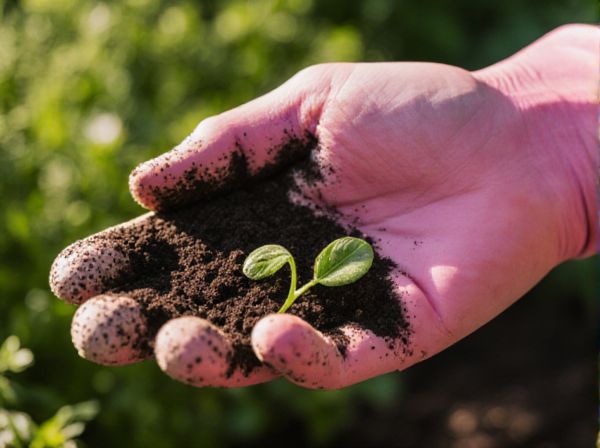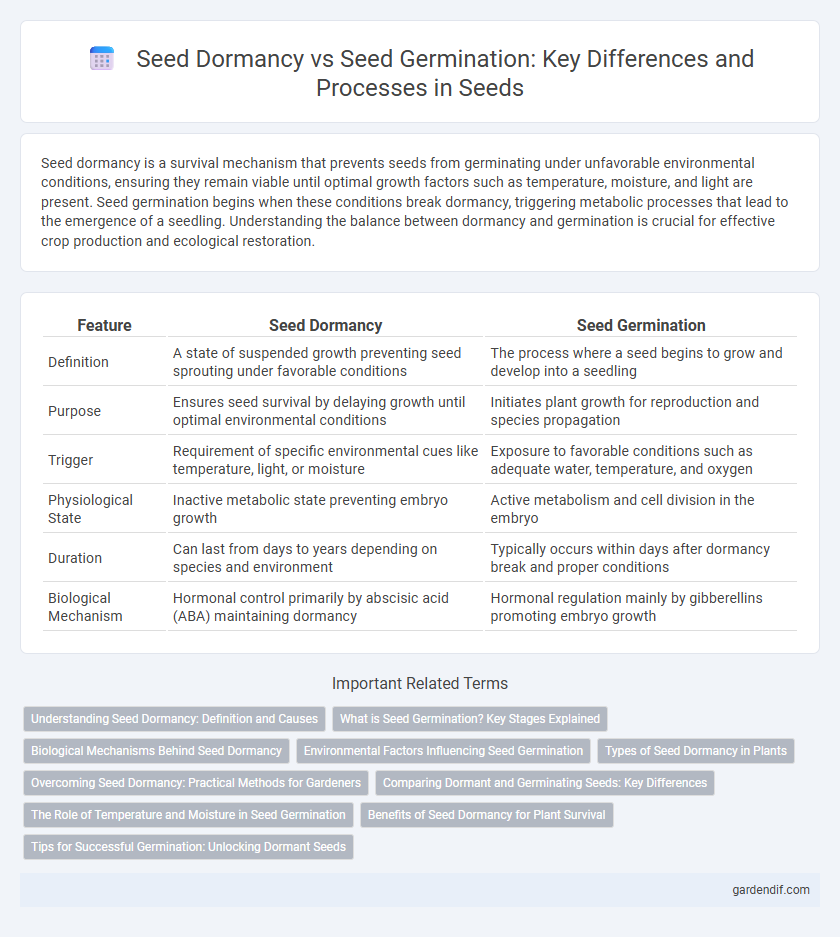
Seed dormancy vs Seed germination Illustration
Seed dormancy is a survival mechanism that prevents seeds from germinating under unfavorable environmental conditions, ensuring they remain viable until optimal growth factors such as temperature, moisture, and light are present. Seed germination begins when these conditions break dormancy, triggering metabolic processes that lead to the emergence of a seedling. Understanding the balance between dormancy and germination is crucial for effective crop production and ecological restoration.
Table of Comparison
| Feature | Seed Dormancy | Seed Germination |
|---|---|---|
| Definition | A state of suspended growth preventing seed sprouting under favorable conditions | The process where a seed begins to grow and develop into a seedling |
| Purpose | Ensures seed survival by delaying growth until optimal environmental conditions | Initiates plant growth for reproduction and species propagation |
| Trigger | Requirement of specific environmental cues like temperature, light, or moisture | Exposure to favorable conditions such as adequate water, temperature, and oxygen |
| Physiological State | Inactive metabolic state preventing embryo growth | Active metabolism and cell division in the embryo |
| Duration | Can last from days to years depending on species and environment | Typically occurs within days after dormancy break and proper conditions |
| Biological Mechanism | Hormonal control primarily by abscisic acid (ABA) maintaining dormancy | Hormonal regulation mainly by gibberellins promoting embryo growth |
Understanding Seed Dormancy: Definition and Causes
Seed dormancy is a survival mechanism that prevents seeds from germinating under unfavorable environmental conditions, ensuring optimal timing for growth. It is caused by physiological factors such as embryo immaturity, impermeable seed coats, or the presence of chemical inhibitors like abscisic acid. Understanding these causes helps in manipulating dormancy to improve germination rates in agriculture and horticulture.
What is Seed Germination? Key Stages Explained
Seed germination is the process by which a seed emerges from dormancy and begins to grow into a new plant, initiated by water absorption and enzymatic activation. Key stages include imbibition, where the seed absorbs water; activation of metabolic pathways leading to embryo growth; and radicle emergence, marking the visible start of seedling development. Environmental factors such as temperature, oxygen, and light influence these stages, ensuring optimum conditions for successful plant establishment.
Biological Mechanisms Behind Seed Dormancy
Seed dormancy is regulated by complex biological mechanisms involving hormonal controls such as abscisic acid (ABA) and gibberellins (GA), which balance growth inhibition and promotion. The accumulation of ABA maintains dormancy by restricting embryo growth and preventing premature germination, while a reduction in ABA and an increase in GA trigger seed germination. Environmental cues like temperature, light, and moisture influence these hormonal changes, activating gene expression pathways that break dormancy and initiate embryo development.
Environmental Factors Influencing Seed Germination
Environmental factors such as temperature, moisture, light, and oxygen levels critically influence seed germination by affecting metabolic processes within the seed. Temperature fluctuations can break seed dormancy by triggering enzymatic activities that promote embryo growth, while adequate moisture activates cellular functions necessary for germination. Light requirements vary among species, with some seeds needing exposure to specific light wavelengths to stimulate germination, highlighting the complex interaction between environmental cues and seed physiology.
Types of Seed Dormancy in Plants
Seed dormancy in plants occurs in several types, including physical dormancy caused by an impermeable seed coat, physiological dormancy regulated by internal hormonal balances such as abscisic acid, and morphological dormancy where underdeveloped embryos require further growth before germination. Combination dormancy integrates both physical and physiological factors, enhancing survival by preventing premature germination under unfavorable conditions. Understanding these dormancy types is crucial for effective seed germination management and improving crop yield.
Overcoming Seed Dormancy: Practical Methods for Gardeners
Overcoming seed dormancy is crucial for successful seed germination and plant growth. Practical methods to break dormancy include stratification, which involves exposing seeds to cold and moist conditions to simulate winter, and scarification, where the seed coat is physically or chemically weakened to allow water absorption. Using these techniques enhances germination rates by triggering metabolic processes necessary for seed sprouting.
Comparing Dormant and Germinating Seeds: Key Differences
Dormant seeds exhibit physiological and biochemical states that inhibit germination despite favorable conditions, characterized by low metabolic activity and intact seed coats. Germinating seeds show increased enzymatic activity, metabolic processes, and water uptake, leading to embryo growth and seed coat rupture. Key differences include hormonal regulation, with abscisic acid prevailing in dormant seeds and gibberellins promoting germination.
The Role of Temperature and Moisture in Seed Germination
Temperature and moisture are critical factors influencing seed germination by activating metabolic processes within the seed embryo. Optimal temperature ranges vary among species but generally promote enzymatic activity necessary for breaking seed dormancy and allowing water uptake during imbibition. Adequate soil moisture ensures hydration and gas exchange, which are essential for cellular respiration and radicle emergence, effectively triggering the transition from seed dormancy to active germination.
Benefits of Seed Dormancy for Plant Survival
Seed dormancy enhances plant survival by preventing germination during unfavorable environmental conditions, ensuring seeds only sprout when temperature, moisture, and light support seedling growth. This adaptive trait reduces seedling mortality, increasing the likelihood of successful reproduction and population stability over time. Dormancy also promotes seed dispersal by delaying germination, allowing seeds to colonize diverse habitats and avoid intense competition.
Tips for Successful Germination: Unlocking Dormant Seeds
Breaking seed dormancy requires precise control of environmental factors such as temperature, moisture, and light to trigger successful germination. Techniques including stratification, scarification, and soaking enhance seed coat permeability and activate metabolic processes essential for embryo growth. Monitoring optimal conditions like substrate moisture and warmth ensures higher germination rates and vigorous seedling development.
Seed dormancy vs Seed germination Infographic

 gardendif.com
gardendif.com